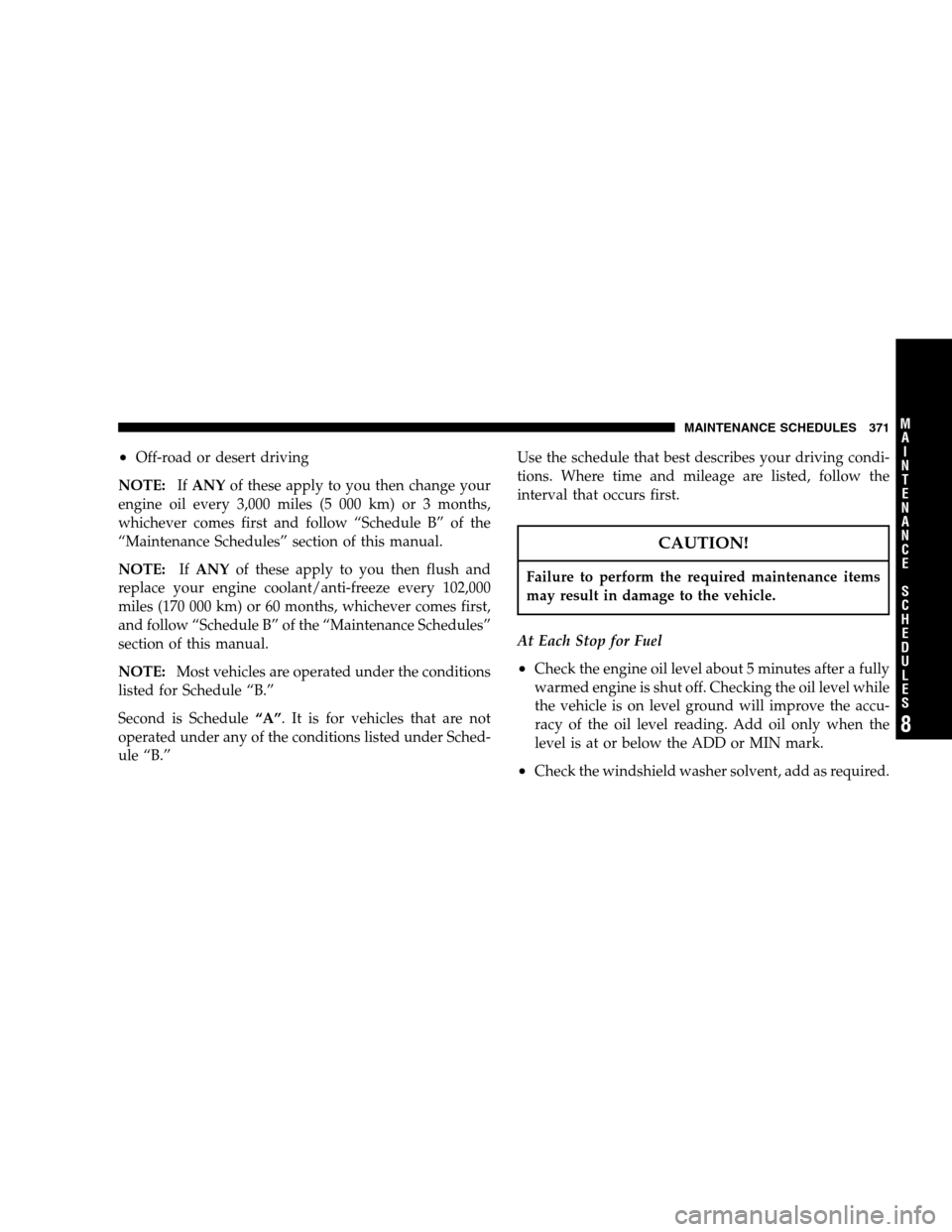Page 197 of 417

mode when any other button is pushed, the ignition is
turned OFF, or 5 minutes has passed since any button
was pushed.
Selecting Satellite Mode in RBB, RAH and RBK
Radios
Press the MODE button repeatedly until�SA�appears in
the display. A CD or tape may remain in the radio while
in the Satellite radio mode.
Selecting Satellite Mode in RBP, RBU, RAZ, RB1
and RBQ Radios
Press the MODE button repeatedly until the word
�SIRIUS�appears in the display. These radios will also
display the following:
•After 3 seconds, the current channel name and channel
number will be displayed for 5 seconds.
•The current program type and channel number will
then be displayed for 5 seconds.
•The current channel number will then be displayed
until an action occurs.
A CD or tape may remain in the radio while in the
Satellite radio mode.
Selecting a Channel
Press and release the SEEK or TUNE buttons to search for
the next channel. Press the top of the button to search up
and the bottom of the button to search down. Holding the
TUNE button causes the radio to bypass channels until
the button is released.
Press and release the SCAN button (if equipped) to
automatically change channels every 7 seconds. The
radio will pause on each channel for 7 seconds before
moving on to the next channel. The word�SCAN�will
appear in the display between each channel change. Press
the SCAN button a second time to stop the search.
UNDERSTANDING YOUR INSTRUMENT PANEL 197
4
Page 198 of 417

NOTE:Channels that may contain objectionable content
can be blocked. Contact Sirius Customer Care at 888-539-
7474 to discuss options for channel blocking or unblock-
ing. Please have your ESN/SID information available.
Storing and Selecting Pre-Set Channels
In addition to the 10 AM and 10 FM pre-set stations, you
may also commit 10 satellite stations to push button
memory. These satellite channel pre-set stations will not
erase any AM or FM pre-set memory stations. Follow the
memory pre-set procedures that apply to your radio.
Using the PTY (Program Type) Button (If
Equipped)
Follow the PTY button instructions that apply to your
radio.
PTY Button�SCAN�
When the desired program type is obtained, press the
�SCAN�button within five seconds. The radio will play 7
seconds of the selected channel before moving to the next
channel of the selected program type. Press the�SCAN�
button a second time to stop the search.
NOTE:Pressing the�SEEK�or�SCAN�button while
performing a music type scan will change the channel by
one and stop the search. Pressing a pre-set memory
button during a music type scan, will call up the memory
channel and stop the search.
PTY Button�SEEK�
When the desired program is obtained, press the�SEEK�
button within five seconds. The channel will change to
the next channel that matches the program type selected.
198 UNDERSTANDING YOUR INSTRUMENT PANEL
Page 202 of 417

If you press the switch up or down twice it plays the
second track, three times, it will play the third, etc.
The button in the center of the left hand switch will cause
the CD changer to play the next available disc in the
6–disc magazine.
CD/DVD DISC MAINTENANCE
To keep the CD/DVD discs in good condition, take the
following precautions:
1. Handle the disc by its edge; avoid touching the
surface.
2. If the disc is stained, clean the surface with a soft cloth,
wiping from center to edge.
3. Do not apply paper, paper CD labels, or tape to the
disc; avoid scratching the disc.
4. Do not use solvents such as benzine, thinner, cleaners,
or antistatic sprays.5. Store the disc in its case after playing.
6. Do not expose the disc to direct sunlight.
7. Do not store the disc where temperatures may become
too high.
RADIO OPERATION AND CELLULAR PHONES
Under certain conditions, the cellular phone being ON in
your vehicle can cause erratic or noisy performance from
your radio. This condition may be lessened or eliminated
by relocating the cellular phone antenna. This condition
is not harmful to the radio. If your radio performance
does not satisfactorily “clear” by the repositioning of the
antenna, it is recommended that the radio volume be
turned down or off during cellular phone operation.
202 UNDERSTANDING YOUR INSTRUMENT PANEL
Page 333 of 417

Exhaust System
The best protection against carbon monoxide entry into
the vehicle body is a properly maintained engine exhaust
system.
If you notice a change in the sound of the exhaust system;
or if the exhaust fumes can be detected inside the vehicle;
or when the underside or rear of the vehicle is damaged;
have an authorized technician inspect the complete ex-
haust system and adjacent body areas for broken, dam-
aged, deteriorated, or mispositioned parts. Open seams
or loose connections could permit exhaust fumes to seep
into the passenger compartment. In addition, inspect the
exhaust system each time the vehicle is raised for lubri-
cation or oil change. Replace as required.
Cooling System
WARNING!
You or others can be badly burned by hot antifreeze/
coolant or steam from your radiator. If you see or
hear steam coming from under the hood, don’t open
the hood until the radiator has had time to cool.
Never try to open a cooling system pressure cap
when the radiator or coolant bottle is hot.
Engine Coolant Checks
Check antifreeze/coolant protection every 12 months
(before the onset of freezing weather, where applicable).
If antifreeze/coolant is dirty or rusty in appearance, the
system should be drained, flushed and refilled with fresh
antifreeze/coolant. Check the front of the A/C condenser
(if equipped) or radiator for any accumulation of bugs,
MAINTAINING YOUR VEHICLE 333
7
Page 371 of 417

•Off-road or desert driving
NOTE:IfANYof these apply to you then change your
engine oil every 3,000 miles (5 000 km) or 3 months,
whichever comes first and follow “Schedule B” of the
“Maintenance Schedules” section of this manual.
NOTE:IfANYof these apply to you then flush and
replace your engine coolant/anti-freeze every 102,000
miles (170 000 km) or 60 months, whichever comes first,
and follow “Schedule B” of the “Maintenance Schedules”
section of this manual.
NOTE:Most vehicles are operated under the conditions
listed for Schedule “B.”
Second is Schedule“A”. It is for vehicles that are not
operated under any of the conditions listed under Sched-
ule “B.”Use the schedule that best describes your driving condi-
tions. Where time and mileage are listed, follow the
interval that occurs first.
CAUTION!
Failure to perform the required maintenance items
may result in damage to the vehicle.
At Each Stop for Fuel
•Check the engine oil level about 5 minutes after a fully
warmed engine is shut off. Checking the oil level while
the vehicle is on level ground will improve the accu-
racy of the oil level reading. Add oil only when the
level is at or below the ADD or MIN mark.
•Check the windshield washer solvent, add as required.
MAINTENANCE SCHEDULES 371
8
M
A
I
N
T
E
N
A
N
C
E
S
C
H
E
D
U
L
E
S
Page 387 of 417
Miles 60,000 66,000 72,000 78,000
(Kilometers) (100 000) (110 000) (120 000) (130 000)
[Months] [60] [66] [72] [78]
Change the engine oil and engine oil filter. X X X X
Rotate the tires. X X X X
Inspect the engine air filter element, and replace if nec-
essary.X
Inspect the PCV Valve, and replace if necessary. X
Replace the spark plugs.X
Inspect the brake linings. X
Inspect the drive belt, and replace as needed. X
Inspect the drive belt, and replace as needed. Not re-
quired if belt was previously replaced.X
Flush and replace the engine coolant/anti-freeze. Where
both time and mileage are indicated, follow the interval
which occurs first.X
Inspect the manual transmission fluid, add as necessary. X
Inspect transfer case fluid, add as necessary. X
SCHEDULE “A” 387
8
M
A
I
N
T
E
N
A
N
C
E
S
C
H
E
D
U
L
E
S
Page 390 of 417
Miles 132,000 138,000 144,000 150,000
(Kilometers) (220 000) (230 000) (240 000) (250 000)
[Months] [132] [138] [144] [150]
Change the engine oil and engine oil filter. X X X X
Rotate the tires. X X X X
Inspect the engine air filter element, and replace if necessary.X
Inspect the PCV Valve, and replace if necessary. X
Replace the spark plugs.X
Inspect the brake linings. X
Inspect the drive belt, and replace as needed. Not required if
previously replaced.XX
Inspect the manual transmission fluid, add as necessary. X
Inspect the transfer case fluid, add as necessary. X
Flush and replace the engine coolant/anti-freeze, if not done
at 120,000 miles (200 000 km).X
Inspection and service should also be performed anytime a
malfunction is observed or suspected. Retain all receipts. This maintenance is recommended by the manufac-
turer to the owner, but is not required to maintain
emissions warranty.
390 SCHEDULE “A”
8
M
A
I
N
T
E
N
A
N
C
E
S
C
H
E
D
U
L
E
S
Page:
< prev 1-8 9-16 17-24